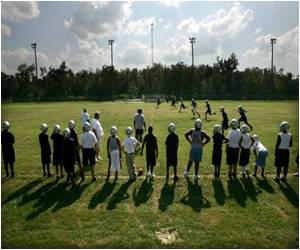
The researchers studied 24 high school football players between the ages of 16 and 18. For all games and practices, players were monitored with Head Impact Telemetry System (HITs) helmet-mounted accelerometers, which are used in youth and collegiate football to assess the frequency and severity of helmet impacts.
Risk-weighted cumulative exposure was computed from the HITs data, representing the risk of concussion over the course of the season. This data, along with total impacts, were used to categorize the players into one of two groups: heavy hitters or light hitters. There were nine heavy hitters and 15 light hitters. None of the players experienced concussion during the season.
All players underwent pre- and post-season evaluation with diffusion tensor imaging (DTI) of the brain. DTI is an advanced MRI technique, which identifies microstructural changes in the brain's white matter.
The results showed that both groups demonstrated global increases of FA over time, likely reflecting effects of brain development. However, the heavy-hitter group showed statistically significant areas of decreased FA post-season in specific areas of the brain, including the splenium of the corpus callosum and deep white matter tracts.
Source-ANI














